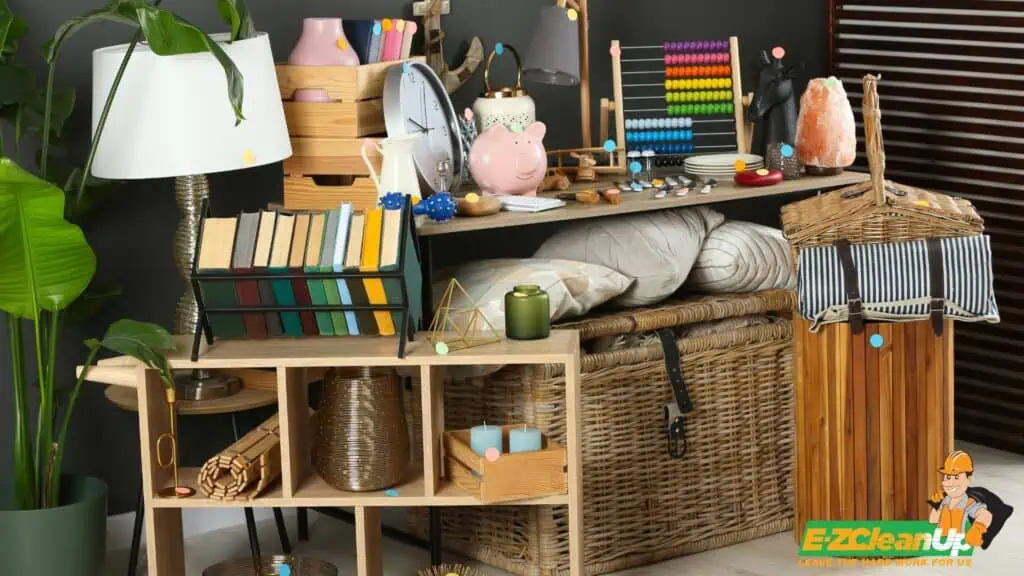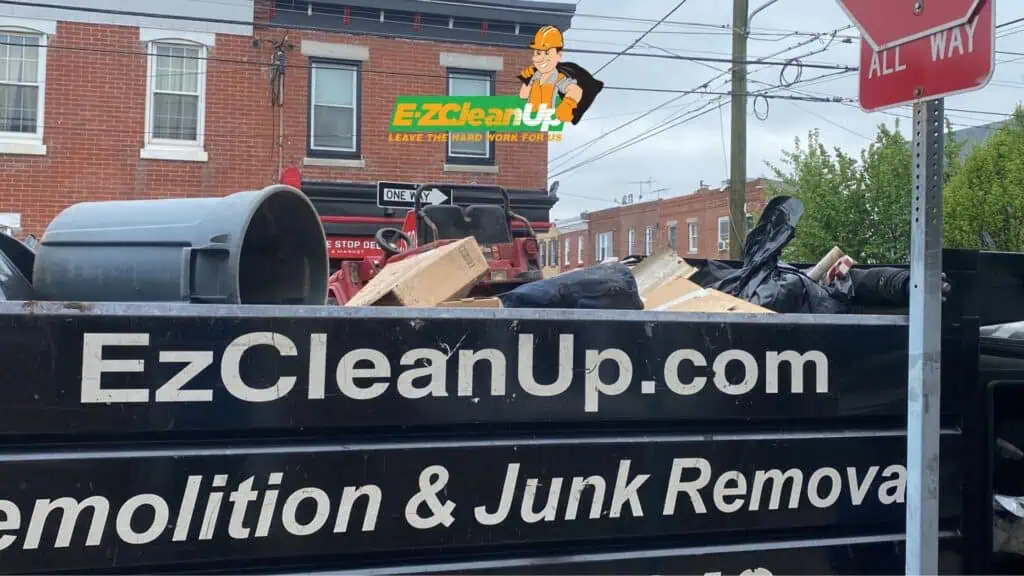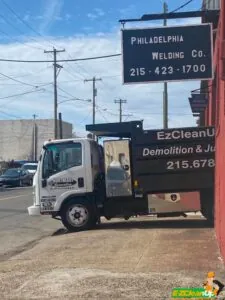Begin downsizing without relocating by evaluating your essentials, decluttering using methods like the Four-Box technique, and optimizing space with smart furniture. Convert to digital to minimize clutter, sell or donate what you don’t need, and maintain a simplified, efficient home environment.
If you want to learn each step of how to downsize without moving, read on.
Step 1: Assess Your Needs and Goals
The first step to effectively downsizing without having to move is to think about what you need compared to what you have. Start by splitting your belongings into two groups: essential and non-essential.
Essentials are the items you use every day that are key to your daily life. Non-essentials are things you don’t use often that just take up space. This might include clothes you haven’t worn in years, old books, or spare household items that are just collecting dust.

Setting Practical Downsizing Goals
Once you’ve figured out what’s essential, the next step is to set realistic goals for your downsizing effort. These goals should fit with how you live and the amount of space you have.
For example, if you want your home to feel more open and tidy, you might aim to get rid of half the things you don’t need. Make these goals clear and achievable.
Write down steps like:
- Decide on a room to start with.
- Plan to tackle a different part of that room every week.
- Choose what to keep, donate, or throw away.
Making It Work
Keep a checklist or a journal of your progress. Each week, as you go through different areas or items, mark off what you’ve completed. This helps keep you motivated and gives you a clear view of how much you’ve accomplished.
Lastly, be patient with yourself. Downsizing is not just about getting rid of stuff—it’s about making your living space better suit your lifestyle. It takes time and effort, but the results can be very rewarding. The goal is to have a simpler, more organized home that feels just right.

Step 2: Declutter Your Home
Decluttering your home begins with sorting your belongings, which can be made easier using the Four-Box Method. This simple technique involves four labeled boxes: “Keep,” “Donate/Sell,” “Discard,” and “Relocate.”
By categorizing each item into one of these boxes, you can make quick decisions without getting sidetracked or overwhelmed by the amount of stuff you have.
How to Use the Four-Box Method
- Choose Your Starting Point: Begin in a specific area, like a bedroom or a closet. This helps prevent the feeling of being overwhelmed.
- Evaluate Each Item: Take each item and decide which box it belongs in. Ask yourself practical questions like, “When was the last time I used this?” or “Does this item make me happy?” These questions make it easier to decide whether to keep, donate, sell, or throw away each item.
- Process the Boxes:
- Keep: Put these items back in a more organized way.
- Donate/Sell: Items in good condition can find a new home or bring in some extra cash.
- Discard: Safely dispose of things that are no longer usable.
- Relocate: Move items to more suitable places in your home.
Decluttering can transform more than just your physical spaces; it can also reduce stress and improve your overall well-being. A less cluttered home means less time spent cleaning and more time for activities you enjoy. It also makes your living environment more inviting and calming.
Step 3: Make the Most of Your Space
Optimizing your living space starts with how you arrange your furniture. A well-planned layout can make your home feel bigger and more welcoming. Think about using multifunctional furniture that serves more than one purpose without taking up extra room.
For example, stair shelving or windowsill seats can turn unused areas into functional spaces. These clever furniture solutions make your home work better for you while adding a touch of unique style.
Choose Smart, Multipurpose Furniture
Investing in furniture that can adapt to different needs is key, especially in smaller living spaces. Consider items like:
- Modular sofas that can be rearranged to fit different room layouts.
- Storage beds that offer extra space for keeping linens and out-of-season clothing out of sight.
- Convertible tables that can expand from a coffee table to a dining table when needed.
This type of furniture combines functionality with style. A sofa that converts into a bed is perfect for hosting guests without needing a spare room. Similarly, a coffee table that turns into a dining area is ideal for small apartments where space is at a premium.

Utilize Hidden Storage Solutions
Another way to maximize your living area is by choosing furniture with built-in storage. Ottomans that open up to reveal storage space, or beds with built-in drawers, help keep your space organized and clutter-free.
These storage solutions are incredibly helpful for maintaining a tidy home, as they allow you to store items neatly out of sight, which is essential in maintaining a peaceful and orderly environment.
Bringing It All Together
By carefully selecting and positioning furniture, you can make your home more functional and stylish. The goal is to create a space that feels open, comfortable, and efficient. With the right furniture choices, even the smallest home can feel spacious and well-organized.
Step 4: Digitize Physical Items
Transitioning from physical to digital formats enhances accessibility and minimizes storage needs. Begin by selecting appropriate equipment—high-quality scanners or multifunction devices are recommended.
For documents, using Optical Character Recognition (OCR) technology can convert scanned images into editable and searchable files. When digitizing photos, consider the resolution; 300 DPI is standard for printing, while higher resolutions are ideal for detailed work or enlargements.
Store digital files in formats that suit your needs: JPEG for basic needs, PNG for higher quality, and TIFF for the best quality and editing flexibility.
Organize Files and Unsubscribe from Unused Services
Effective digital organization involves more than just scanning and saving. Develop a systematic approach to naming and storing files to ensure they are easy to locate and access. Use cloud storage solutions for accessibility and backup, and ensure data is secure through encryption and proper security measures.
Regularly review and clean your digital files to maintain organization and efficiency. This also involves unsubscribing to unused digital services and email subscriptions to keep your digital space clutter-free and manageable.
Step 5: Implement Smart Storage Solutions
Maximizing vertical space is crucial in small living areas. Consider wall-mounted furniture like foldable desks and tables, which provide functional workspaces that can be tucked away when not in use.
Hanging storage solutions, such as hooks, pegboards, and magnetic strips, offer versatile options for keeping everyday items within reach and off the floor. These installations enhance the functionality of a space and contribute to a cleaner, more organized environment.
Explore Hidden Storage Opportunities
Under-stair storage, narrow cabinets, and furniture with built-in storage are innovative solutions for making the most of underused areas in your home. Under-stair drawers or shelves can transform this typically overlooked space into a highly functional storage area for books, household supplies, or seasonal items.
Similarly, slim rolling shelves can fit into tight spaces, such as between a fridge and a wall. They are ideal for storing spices, condiments, or other small items. This approach optimizes space and maintains accessibility and organization.

Step 6: Sell or Donate Unwanted Items
Organizing a yard sale can be a practical way to declutter and earn some extra cash. To ensure success, select a visible location with easy access and ample parking. Advertise effectively using both print (like bright, clear signage) and digital platforms (such as social media and local online classifieds).
Prepare by pricing items clearly and setting them up in an organized, attractive manner. Have sufficient change and bags available for customers, and consider extending the sale over multiple days to maximize traffic.
Donate Items to Local Charities or Thrift Stores
For items that don’t sell, or if you prefer a simpler option, donating to local charities or thrift stores is an excellent choice. Ensure that the items are clean and in good condition. Many organizations offer pick-up services for larger donations. This makes it convenient to clear out bulkier items.
Step 7: Maintain Your Downsized Environment
Maintaining a clutter-free environment requires consistent effort and smart habits. One effective strategy is the “one-in, one-out” rule, which helps control the accumulation of new items by ensuring something old is removed whenever something new is added.
Regularly designating a place for each item and immediately putting things away after use can dramatically reduce clutter. Additionally, consider employing a brief daily cleaning routine to tackle areas that tend to gather mess, like kitchen counters or entryways.
Regularly Reassess Your Stuff
A periodic review of your belongings is crucial to maintaining a minimalist lifestyle. This involves checking physical items and reassessing digital spaces—like emails and digital files—to keep them streamlined and functional.
For physical items, use decluttering strategies you’re familiar with or have worked for you. It will help you take decisive actions about each item’s necessity and keep your space aligned with your current lifestyle needs.

Make Downsizing EZ!
Successfully downsizing your home without relocating involves not just intention but action. EZ CleanUp can handle the heavy lifting, from removing old furniture to disposing of accumulated junk. We help make your goals of a clutter-free home attainable by providing professional cleanout and disposal services tailored to your needs.
Call us to simplify your downsizing project and enhance your living space.













